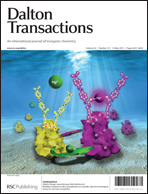Pyridyloxy cyclophosphazenes, spiro-N3P3(O2C12H8)(O-C5H4N-3)4 (L1), dispiro-N3P3(O2C12H8)2(O-C5H4N-3)2 (L2) and dispiro-N3P3(O2C12H8)2(O-C5H4N-4)2 (L3) were prepared and characterized. The crystal structure of L1 was determined which showed that the cyclophosphazene ring is planar. The reaction of L1 with anhydrous copper(II) chloride or silver nitrate afforded L2M4 metallamacrocycles [{L1}2{ClCu(μ-Cl)2CuCl}]2·8CHCl3 (3) and [{L1}2{(DMF)0.5(NO3)0.5Ag}2{Ag(μ2-(O)NO2)(H2O)}2]{μ-[NO3]}·CH3OH (4) respectively. The molecular structure of 3 reveals that two CuCl2 dimers are bridged to each other in a complex metallamacrocycle that involves four metal ions and two ligands. The molecular structure of 4 is similar to that of 3 except for the presence of weak argentophilic interactions between the two Ag(I) centers. Also, a nitrate anion, which is trapped in the centre of the tetrameric assembly, assists in holding two Ag(I) ions together and 4 serves as a single source precursor for silver nanoparticles. The reaction L1 with ZnCl2 and Cd(NO3)2·4H2O afforded the 1D-coordination polymers [{L1}{ZnCl2}2]n·2nCH3OH·2nH2O (5) and [{L1}2{Cd(CH3OH)2(NO3)2}2{Cd(NO3)2(H2O)}]n·3nCH3OH·3nH2O (6) respectively. While in 5 the 20-membered macrocycles are inter-connected directly, in 6 they are bridged by a Cd(II) connector. The reaction of L2 with CoCl2 afforded the 1D-coordination polymer [{L2}2{CoCl2}]n·2nCHCl3 (7) which also contains interconnected 20-membered metallamacrocycles. On the other hand, the reaction of L2 with CuCl2 afforded [{L2}2{ClCu(μ-Cl)}2]n·2nCHCl3·nH2O (8) which is a 1D-coordination polymer that contains {ClCu(μ-Cl)2CuCl} units. The reaction of L3 with CuCl2 and Cd(NO3)2·4H2O afforded [{L3}2{CuCl2}]n·nDMF (9) and [{L3}2{Cd(NO3)2}]n·nCHCl3·nCH2Cl2·nH2O (10) respectively. While 9 is a 2D-coordination polymer containing 48-membered metallamacrocycles, 10 is a 1D-coordination polymer containing interconnected 24-membered metallamacrocycles which possess spirocyclic cadmium ions as nodes.

You have access to this article
 Please wait while we load your content...
Something went wrong. Try again?
Please wait while we load your content...
Something went wrong. Try again?


 Please wait while we load your content...
Please wait while we load your content...